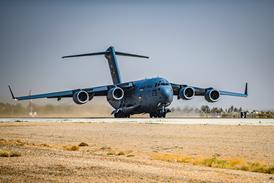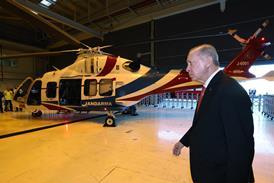The US Department of Defense's tri-service Lockheed Martin F-35 Joint Strike Fighter has been performing well in recent developmental testing, but challenges loom as defence outlays around the world shrink.
The $382 billion programme is the single largest defence procurement in history, but the effort to develop the jet has been mired with technical challenges and price-sticker shock. The DoD hopes to buy 2,443 of the stealthy fifth-generation type. Of those, 1,763 would go to the US Air Force, while the US Marine Corps will buy 420, comprising 340 short take-off and vertical landing (STOVL) F-35Bs and 80 F-35C carrier variants.
The US Navy is also expected to buy 260 aircraft. While the service is officially committed to the JSF endeavour, there are those who question its commitment to the single-engined fighter.
Although US Secretary of Defense Leon Panetta has thrown his strong support behind the programme, the DoD has shown its frustration with the level of concurrency between development and production of the F-35. To help alleviate that problem, production is being held at 30 aircraft per year for the time being.
Ostensibly, the reductions also save money at a time when the US defence budget is being cut by $487 billion over the next 10 years. But a further automatic $500 billion in defence budget cuts that might be triggered in January 2013 could derail the entire F-35 effort.
However, in addition to the US government, the JSF programme includes eight other partner countries around the world: Australia, Canada, Denmark, Italy, the Netherlands, Norway, Turkey and the UK.
Financial concerns in many of those nations could pose a serious challenge to the F-35 programme. The UK has already flip-flopped from the F-35B to the F-35C and back to the F-35B due to financial pressures. The country originally planned to buy 150 aircraft, but then cut that number back to 138. However, the expectation is that the latter figure will be further truncated, with many expecting London ultimately to buy no more than 40 STOVL aircraft.
Italy, which is in dire financial straits, has already downgraded its planned buy from 131 to 90. Meanwhile, Australia has deferred the purchase of 12 of its initial aircraft in order to shore up its balance sheet.
Canada is expected to buy 65 aircraft, but the procurement is mired in controversy. The government failed to disclose the full costs of the programme to the public, the nation's auditor general says.
Norway insists it is committed to buying 52 aircraft, but says it cannot accept drastic increases in price.
However, while some of the partner nations are wavering, Japan has committed to buying 42 F-35s, and Israel will acquire 19 aircraft - and possibly more. But those commitments are also contingent on Lockheed delivering the JSF on time and at the price to which the nations have agreed.
Future sales prospects include South Korea and others. However, those prospects could be in jeopardy if there are further delays or price increases.
On the technical side, there have been no major revelations as of late. In any case, the USAF leadership has made it clear that there are no additional dollars to pay for new design fixes.
GETTING HALFWAY
Flight-testing for all three versions of the aircraft are going well, company and programme officials say. The aircraft are about 20% ahead of this year's schedule for completing flight-test points, Lockheed says.
Flight-testing for the USAF's conventional take-off and landing F-35A should be about halfway complete by the end of this year. By the fourth quarter, the model should have completed its first full lifetime in durability testing. Thus far, no new structural issues have emerged since last year's Pentagon Director of Operational Test and Evaluation report, Lockheed says.
Meanwhile, the USMC's STOVL F-35B and the USN's F-35C carrier variant have both completed testing of about half of their full-envelope clean-wing flight test points.
Moreover, the company says that fixes to most of the jet's major problems are well on their way to being implemented. Lockheed has redesigned the tail-hook for the F-35C, which was failing to catch an arresting wire. A critical design review of the new tail-hook design is expected in the fourth quarter. Should the redesign pass muster, the carrier variant aircraft will undergo sea trials late in 2013 or early in 2014.
The F-35B was taken off "probation" in January, when Panetta noted that the STOVL version had been performing better and had caught up with the two other variants. Successful sea trials onboard the USS Wasp last October, no doubt, helped the USMC's case.
Meanwhile, fixes to imagery problems with the F-35's helmet will be tested this summer. The fixes should resolve problems with imagery lag, jittery images and night-vision acuity.
Lockheed has also added more resources to write and test the millions of lines of software code that will run 80% of the F-35's functionality. DoD officials often reiterate that software is their single biggest concern on the programme.
The F-35 is moving into more challenging areas of flight-testing later this year, Lockheed says. All versions of the jet have started flying with external stores, but the aircraft will also start testing weapon releases. The type will also enter into high-angle-of-attack testing, with the ultimate goal to clear the aircraft to a 50˚ angle.
The aircraft will also have to undergo wet runway tests and engine air starts this year.
While flight-testing is ongoing at Edwards AFB, California, the DoD is moving forward with the start of training operations for the new fighter. The USAF received permission to start local area flights around Eglin AFB, Florida - the initial training location - in March. However, at first only two test pilots were allowed to fly the F-35A.
The USMC also started local area flights with its F-35Bs on 22 May. The service is starting by flying the STOVL jet purely in conventional flight, but will gradually introduce jet-borne lift as pilots become more familiar with the aircraft.
The first non-test pilot at the Florida base to start converting to the F-35 began flying the aircraft on 8 May. After a transition course consisting of six flights, Lt Col Lee Kloos became the first person who is not a graduate of a test pilot school to become qualified in the F-35 on 31 May.
TRAINING THE TRAINERS
As part of the first batch of instructors for the fifth-generation fighter, Kloos will help train the rest of the initial cadre of F-35 pilots at the seaside base. Eglin needs to have four instructor pilots trained in order to start the F-35's Operational Utility Evaluation (OUE) in the summer.
The OUE will determine if the USAF is ready to train new pilots to fly the F-35. If it is successful, the service's Air Education and Training Command will approve the unit to formally start training.
The USAF currently only has two F-35 instructors at Eglin: Kloos and his director of operations, test pilot Lt Col Eric Smith. It has an additional two pilots who are awaiting approval to start their flight training. Once qualified to fly the F-35, the cadre will teach four new "students" for the OUE.
Student, however, is a relative term, as the four students are highly experienced fighter pilots. Two are 33rd Fighter Wing initial cadre pilots, while two are from the elite 31st Test and Evaluation Squadron (TES). The participation of the latter two is particularly significant, as it heralds the Pentagon's Joint Operational Test Team's first operational evaluation of the type.
The 31st TES, which is based at Edwards AFB alongside the developmental test activity, should be receiving its first four jets later this year. Subsequently, the 422nd TES at Nellis AFB, Nevada, will receive its first four aircraft.
Initially, the 31st TES will fly local flight operations to familiarise the pilots and assist with the developmental test effort, but its main role will be to prepare for initial operational test and evaluation in a few years.
The services have yet to set a formal date for the F-35's initial operational capability (IOC). But USAF and USN leaders have previously testified before Congress that it could happen in 2018. Both services have said that they would not accept anything less than the full Block 3 software capability at IOC.
Source: Flight International























